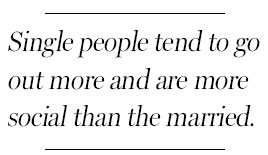Alone, but not lonely
Updated: 2012-02-12 07:51
(The New York Times)
|
|||||||||

The thought of living alone once sparked anxiety and visions of loneliness. But now the most privileged people on earth use their resources to buy privacy and personal space.
More people live alone than at any other time in history. In Paris, the city of lovers, more than half of all households contain single people, and in socialist Stockholm, the rate tops 60 percent.
The decision to live alone is common in diverse cultures whenever it is economically feasible. Although Americans pride themselves on their self-reliance and culture of individualism, Germany, France and Britain have a greater proportion of one-person households than the United States, as does Japan. Three of the nations with the fastest-growing populations of single people - China, India and Brazil - are also among those with the fastest growing economies.

Living alone promotes freedom, personal control and self-realization - all prized aspects of contemporary life.
And living alone no longer suggests an isolated or less-social life. After interviewing more than 300 people who live alone during nearly a decade of research, I've concluded that living alone seems to encourage more, not less, social interaction.
Paradoxically, our species, so long defined by groups and by the nuclear family, has been able to increase its solo living because global societies have become so interdependent. Dynamic markets, flourishing cities and open communications systems make modern autonomy more appealing; they give us the capacity to live alone but to engage with others when and how we want to.
In fact, living alone can make it easier to be social, because single people have more free time, absent family obligations, to engage in social activities.
Single people are more likely than married ones to spend time with friends and neighbors, go to restaurants and attend art classes and lectures. Erin Cornwell, a sociologist at Cornell University in Ithaca, New York, analyzed results from the General Social Survey (which draws on a nationally representative sample of the United States population) from 2000 to
2008 and found that single people 35 and older were more likely than those who lived with a spouse or a romantic partner to spend a social evening with neighbors or friends. In 2008, her husband, Benjamin Cornwell (also a sociologist at Cornell), was lead author of a paper in the American Sociological Review that showed that single seniors had the same number of friends and discussion partners as their married peers and were more likely to socialize.
Surveys also indicate that married parents are more likely than single people to stay at home. Those in large suburban homes often splinter into private rooms to be alone. The image of a modern family in a room together, each member plugged into a smartphone, computer, video game or TV show has become a cultural cliche.
New communications technologies make living alone a social experience, so being home alone does not feel like solitary confinement. The Internet opens up a world of people, information and ideas, and does not seem to cut people off from real friendships and connections.

Today five million people in the United States between ages 18 and 34 live alone, 10 times more than in 1950. But the largest number of single people are middle-aged; 15 million people between ages 35 and 64 live alone. Those who decide to live alone said in interviews that they chose to live alone because they had found there was nothing worse than living with the wrong person.
In my interviews, older single people expressed a clear preference for living alone, which allowed them to retain their feelings of independence and integrity, and a clear aversion to moving in with friends or family or into a nursing home.
According to research by Deborah Carr, a sociologist at Rutgers University in New Jersey, at 18 months after the death of a spouse, only one in four elderly men and one in six elderly women say they are interested in remarrying; one in three men and one in seven women are interested in dating someday; and only one in four men and one in 11 women are interested in dating immediately.
Most older widows, widowers and divorced people live alone. According to Kathleen McGarry, an economist at the University of California, Los Angeles: "When they have more income and they have a choice of how to live, they choose to live alone. They buy their independence."

Some unhealthy old people do become dangerously isolated, as I learned when I researched my book about the hundreds of people who died alone in the 1995 Chicago heat wave. Thousands of elderly people died alone in the European heat wave of 2003. But many people over age 65 maintain domestic independence far longer than previous generations did. What's new is that the great majority prefer living alone to their other options, and they're willing to spend more on housing and domestic help for the privilege.
True, the challenged economy has forced more young adults to move in with their parents because they cannot find good jobs; but in America the proportion of those between 20 and 29 who live alone went down only slightly, from 11.97 percent in 2007 to 10.94 percent in 2011. In the general population, living alone has become more common - in absolute and proportional terms.
The latest United States census report estimates that more than 32 million Americans live alone today, up from 27.2 million in 2000 and 31 million in 2010.
All signs suggest that living alone will become even more common in the future, at every stage of adulthood and in every place where people can afford a place of their own.
Eric Klinenberg is a professor of sociology at New York University and the author of "Going Solo: The Extraordinary Rise and Surprising Appeal of Living Alone."
(China Daily 02/12/2012 page9)